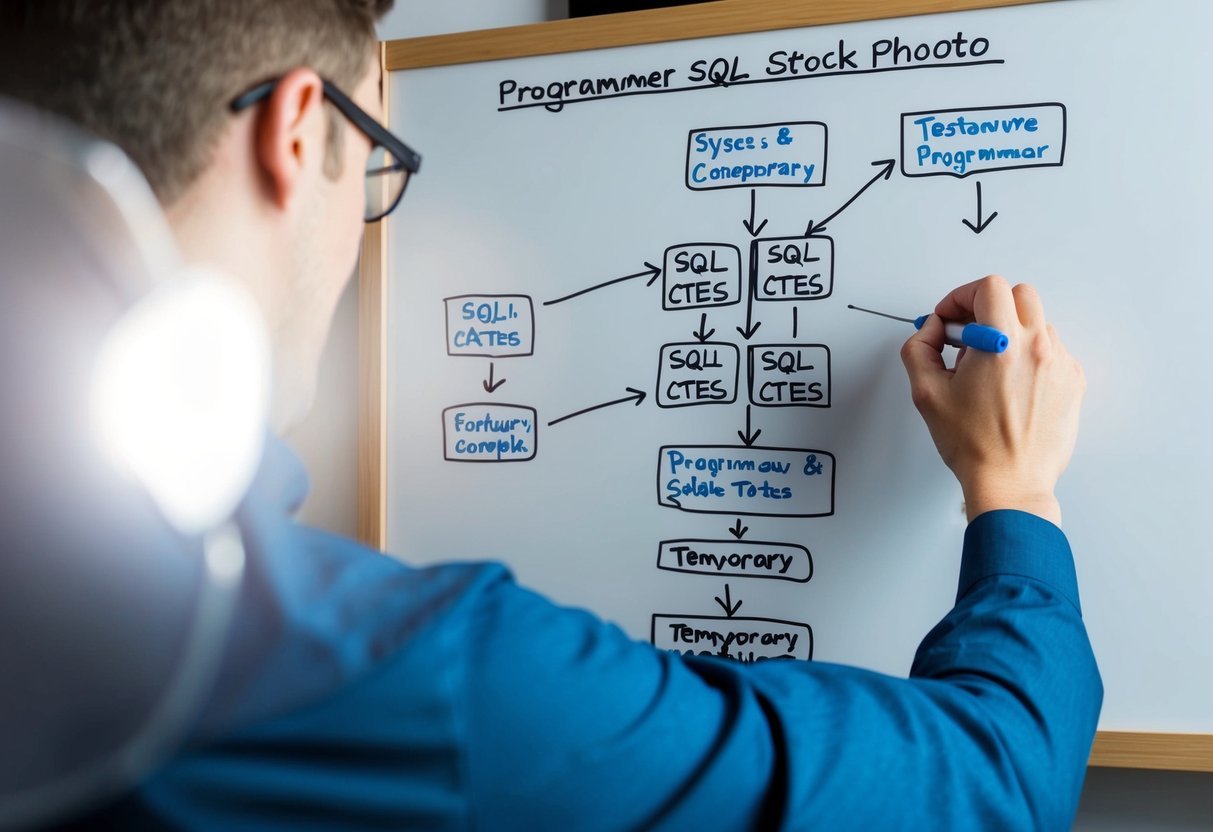Understanding Common Table Expressions: An Introduction to CTEs
Common Table Expressions, or CTEs, in SQL are temporary result sets. They make complex queries easier to manage and enhance readability.
By structuring these result sets with defined names, CTEs can simplify challenging SQL operations without creating permanent tables.
Defining the Basics of CTEs
A Common Table Expression (CTE) acts as a temporary table. It is created directly within a SQL statement and used immediately within that query.
CTEs are particularly useful for breaking down complex queries into smaller, more readable parts. They are defined by using the WITH clause, followed by the CTE name and the query that generates the dataset.
CTEs excel in handling tasks like managing duplicates, filtering data, or performing recursive querying. In SQL, this makes them essential for developers dealing with nested queries or self-referential data.
Exploring the Syntax of Common Table Expressions
The syntax of a CTE begins with the WITH keyword. This is followed by the name of the CTE, enclosed in parentheses, and the query needed to form the result set. A basic example looks like this:
WITH CTE_Name (Column1, Column2) AS (
SELECT Column1, Column2
FROM SomeTable
)
SELECT * FROM CTE_Name;
This straightforward structure allows SQL developers to implement temporary tables without altering the database structure.
Using CTEs avoids cluttering queries with complex nested subqueries, enhancing overall code maintenance and comprehension.
CTE Versus Subquery: Comparing Techniques
When comparing CTEs with subqueries, both are used to simplify complex SQL operations. Subqueries are enclosed within the main query and can be highly nested, sometimes impacting readability.
CTEs, in contrast, appear at the beginning of a SQL statement and provide a clear, named reference to use later in the query.
CTEs are particularly advantageous for recursive operations, a task that subqueries struggle with. The recursive nature of CTEs allows repeated execution of a query set until a certain condition is met, which greatly aids in tasks involving hierarchical data.
SQL Temporary Tables: Definition and Usage
SQL temporary tables are essential for handling intermediate data during complex query processing. They allow users to break down queries into manageable steps by storing temporary results that can be referenced multiple times within the same session. This section explores how to create and use temporary tables effectively and examines how they differ from common table expressions (CTEs).
Creating and Utilizing Temporary Tables
To create a temporary table in SQL, the CREATE TEMPORARY TABLE statement is used. Temporary tables exist only during the session in which they were created. Once the session ends, the table is automatically dropped, allowing for efficient resource management.
These tables are ideal for storing data that needs to be processed in multiple steps, like aggregated calculations or intermediate results. Temporary tables can be used similarly to regular tables. They support indexes, constraints, and even complex joins, providing flexibility during query development.
For example, if a query requires repeated references to the same dataset, storing this data in a temporary table can improve readability and performance.
Temporary Tables Versus CTEs: A Comparative Analysis
While both temporary tables and common table expressions (CTEs) can handle complex queries, they have distinct features and use cases.
Temporary tables are explicitly created and persist for the duration of a session. This persistence allows for indexing, which can improve performance in larger datasets.
In contrast, CTEs are defined within a single query’s execution scope. They are intended for readability and simplifying recursive queries but lack the ability to persist data between queries.
This makes CTEs suitable for scenarios where data access does not require indexing or multiple query execution. For more details on this comparison, refer to a discussion on temporary tables vs. CTEs.
Optimizing Query Performance with CTEs
Common Table Expressions (CTEs) can greatly impact SQL query performance when used effectively. They provide ways to use indexing, improve readability with joins, and optimize recursive queries. Understanding these elements can enhance the efficiency of CTEs in large or complicated databases.
Utilizing Indexing for Enhanced CTE Performance
Indexing plays a crucial role in improving the performance of a query involving CTEs. Though CTEs themselves cannot directly use indexes, they can benefit from indexed base tables.
Proper indexing of underlying tables ensures faster data retrieval, as indexes reduce the data to be scanned. Using indexes smartly involves analyzing query plans to identify which indexes may optimize data access patterns.
Testing different index types may provide varying performance boosts. Indexes should be chosen based on the unique access patterns of queries involving the CTE.
Improving Readability and Performance with Joins in CTEs
Joins can enhance both clarity and performance in queries using CTEs. By breaking a large query into smaller, manageable components, readability improves, making debugging and maintenance easier.
Well-structured joins can also reduce computational overhead by filtering data early in the process. Joins should be designed to eliminate unnecessary data processing. This can involve selecting only relevant columns and using inner joins where appropriate.
By limiting the data processed, query speed increases, and resources are used more efficiently. This method often results in a more transparent and efficient query execution.
Optimizing Recursive Common Table Expressions
Recursive CTEs allow complex hierarchical data processing, but they need optimization for performance gains. Without careful design, they may lead to long execution times and excessive resource use.
Setting a recursion limit can help prevent excessive computation, especially with large datasets. Using appropriate filtering criteria within a recursive CTE is essential.
This involves limiting the recursion to relevant records and ensuring base cases are well-defined. With this approach, recursive operations can process data more efficiently, minimizing the workload on the SQL server. Understanding the recursive logic and optimizing it can drastically improve query processing times.
Advanced SQL: Recursive CTEs for Hierarchical Data
Recursive CTEs are powerful tools in SQL that help manage complex hierarchical data. They simplify tasks like creating organizational charts and handling tree-like structures, making complex data easier to work with and understand.
Understanding Recursive CTEs and Their Syntax
Recursive Common Table Expressions (CTEs) are used to execute repeated queries until a certain condition is met. They are defined with an anchor member and a recursive member.
The anchor member initializes the result set, while the recursive member references the CTE itself, building the result iteratively.
For instance, a recursive CTE can list employees in an organization by starting with a top-level manager and iteratively including their subordinates.
This recursive structure allows developers to handle large and complex queries efficiently. It is essential to carefully construct the recursive part to ensure proper termination conditions to avoid infinite loops.
Building Organizational Charts with Recursive Queries
Organizational charts are an example of hierarchical data that can be modeled using recursive queries. These charts represent employees in a company where each employee reports to a supervisor, forming a hierarchy.
A typical SQL recursive query starts with the top executive and recursively gathers information about each employee’s supervisor. This can be visualized through an organizational chart which clearly shows the hierarchy and relations.
Structuring the query correctly is crucial for retrieving the data without overload, focusing on necessary columns and conditions.
Handling Tree-Like Data Structures Efficiently
Tree-like data structures, such as genealogy trees or file directories, require efficient handling to avoid performance issues. Recursive CTEs provide a way to traverse these structures smoothly by breaking down the queries into manageable parts.
In large datasets, it’s often necessary to optimize the query to prevent retrieving unnecessary information, which can slow down processing time.
By using optimized recursive CTEs, you can improve performance and maintainability by focusing on essential data points and reducing computation load.
Techniques such as simplifying joins and using indexes purposefully contribute to efficient data retrieval and organization.
The Role of CTEs in Database Management Systems
Common Table Expressions (CTEs) are instrumental in simplifying complex queries within database management systems. They improve code readability and efficiency, especially in handling hierarchical or recursive data structures. Different systems like PostgreSQL, SQL Server, MySQL, and Oracle have their specific ways of utilizing these expressions.
CTEs in PostgreSQL: Utilization and Advantages
In PostgreSQL, CTEs are used to streamline intricate SQL queries. They allow for the creation of temporary result sets within a query, making the SQL code more readable and maintainable.
This is particularly helpful when dealing with large and complex data operations. PostgreSQL supports recursive CTEs, which are ideal for solving problems that involve recursive relationships such as organizational charts or family trees.
The natural syntax of CTEs enhances query transparency and debugging. Compared to nested subqueries, CTEs offer a cleaner structure which helps developers quickly identify logical errors or understand query flow.
PostgreSQL’s implementation of CTEs optimizes query execution by allowing them to be referenced multiple times within a query, thus reducing repetition and enhancing performance.
Leveraging CTEs across Different RDBMS: SQL Server, MySQL, and Oracle
In SQL Server, CTEs serve as a powerful tool for improving complex query readability and efficiency. They are defined using the WITH clause and can handle recursive operations effectively, much like in PostgreSQL.
MySQL supports non-recursive CTEs, allowing developers to define temporary result sets to simplify and clarify lengthy queries. This functionality aids in optimizing the query-building process and improves code management within the database environment.
Oracle’s CTE implementation also allows for recursive query capabilities. These features are particularly useful when processing hierarchical data.
CTEs allow for more concise and organized SQL statements, promoting better performance in data retrieval and manipulation tasks. By leveraging CTEs, users can improve both the clarity and execution of SQL queries across these popular RDBMS platforms.
Common Table Expressions for Data Analysis

Common Table Expressions (CTEs) are useful in breaking down complex SQL queries by creating temporary result sets. These result sets can make data analysis more efficient. They are particularly valuable for handling tasks such as aggregating data and evaluating sales performance.
Aggregating Data using CTEs
When working with large datasets, aggregating data can be challenging. CTEs simplify this process by allowing SQL users to create temporary tables with specific data.
This method of aggregating helps in consolidating data from different sources or tables without altering the original data. For example, a CTE can be used to sum up sales by region for a specific period.
Using CTEs, analysts can format results for better readability. They can focus on specific aspects like monthly sales or customer demographics. A CTE might look like this:
WITH RegionalSales AS (
SELECT region, SUM(sales) as total_sales
FROM sales_data
GROUP BY region
)
SELECT * FROM RegionalSales;
This snippet calculates total sales for each region. It can be expanded with more complex logic if needed.
CTEs offer a structured way to perform multiple operations on the dataset, enhancing the capability to conduct meaningful data analysis.
Analyzing Sales Performance with Temporary Result Sets
Sales performance analysis often involves mining through voluminous and intricate data.
Temporary result sets created by CTEs help by holding interim calculations that can be reused in final reports. They allow for an effective breakdown of figures such as quarterly performance or year-over-year growth.
For instance, a company wants to assess the rise or fall in sales over different fiscal quarters.
A CTE can calculate average sales per quarter and track changes over the years. The CTE might look like this:
WITH SalesTrend AS (
SELECT quarter, AVG(sales) as avg_sales
FROM sales_data
GROUP BY quarter
)
SELECT * FROM SalesTrend;
This temporary table extracts average sales per quarter, helping businesses to identify patterns or anomalies in their sales strategies. Using CTEs for such analysis enriches the assessment process, allowing analysts to focus on actionable metrics rather than data complexities.
Managing Complex SQL Queries

Managing complex SQL queries often involves breaking them down into manageable parts.
Using Common Table Expressions (CTEs) and temporary tables helps simplify complex joins and multiple CTEs in one query.
Breaking Down Complex Joins with CTEs
CTEs, or Common Table Expressions, are a helpful tool for handling complex joins.
By using the WITH clause, developers can create temporary named result sets that they can reference later in a query. This approach not only improves readability but also makes it easier to debug.
When working with large datasets, breaking down joins into smaller, more focused CTEs helps in isolating issues that might arise during query execution.
Example:
WITH CustomersCTE AS (
SELECT CustomerID, CustomerName
FROM Customers
)
SELECT Orders.OrderID, CustomersCTE.CustomerName
FROM Orders
JOIN CustomersCTE ON Orders.CustomerID = CustomersCTE.CustomerID;
Using CTEs in this way simplifies understanding complex relationships by clearly defining each step of the process.
Handling Multiple CTEs in a Single Query
In certain scenarios, using multiple CTEs within a single SQL query helps deconstruct complicated problems into simpler sub-queries.
This method allows different parts of a query to focus on specific tasks, ensuring that data transformations occur in a logical sequence. For instance, one CTE might handle initial filtering, while another might perform aggregations. Linking these together provides flexibility and organization.
Example:
WITH FilteredData AS (
SELECT * FROM Sales WHERE Amount > 1000
),
AggregatedData AS (
SELECT SalespersonID, SUM(Amount) AS TotalSales
FROM FilteredData
GROUP BY SalespersonID
)
SELECT * FROM AggregatedData;
Managing multiple CTEs helps separate complex logic, making the query more modular and easier to troubleshoot. These advantages make CTEs powerful tools in the SQL developer’s toolkit.
Best Practices for Writing Efficient SQL CTEs

When writing efficient SQL CTEs, it is crucial to focus on maintaining clear naming conventions and addressing common performance issues. These practices help improve readability and maintainability while ensuring optimal execution.
Naming Conventions and Maintaining a CTE Dictionary
A clear naming convention for CTEs is essential to keep SQL queries understandable.
Descriptive names that reflect the role of the CTE make the code easier to read and maintain. Consistent naming helps when working with multiple CTEs in a complex query.
Creating and maintaining a CTE dictionary can be beneficial in larger projects. This dictionary should include CTE names and brief descriptions of their purpose. By documenting these parts of SQL code, developers can save time and reduce errors when transferring knowledge to other team members.
Avoiding Common Performance Issues
To avoid performance issues, it is vital to understand how SQL engines execute CTEs.
Sometimes, CTEs are materialized as temporary tables, which might impact performance negatively. Analyzing the execution plan helps identify potential bottlenecks.
Avoid using CTEs for simple transformations that can be handled directly in a query, as this could complicate the execution.
Limit the use of recursive CTEs to necessary scenarios since they can be resource-intensive. When structuring complex queries, ensure that CTEs do not include unnecessary columns or calculations to enhance efficiency.
Refactoring Legacy SQL Code with CTEs

Refactoring legacy SQL code using Common Table Expressions (CTEs) can vastly improve both readability and efficiency. By breaking down complex queries into manageable parts, CTEs enable smoother transitions to modern coding practices, offering a clear path away from outdated methods.
Enhancing Code Readability and Reusability
CTEs make SQL code more readable by allowing developers to separate complex queries into smaller, understandable parts.
Each CTE segment acts like a temporary table, helping to organize the code logically. This not only simplifies the debugging process but also makes maintenance easier.
In addition to this, CTEs encourage reusability. By defining common patterns within the query using CTEs, code can be reused in multiple parts of an application, making it adaptable for future changes.
Using CTEs can lead to cleaner and more modular code, which developers can quickly understand and use. This improvement in code readability and reusability is particularly useful when dealing with a large codebase containing legacy SQL code.
Transitioning from Legacy Practices to Modern Solutions
Transitioning from legacy SQL practices to using CTEs involves understanding both the limitations of traditional queries and the benefits of modern SQL features.
Legacy systems often rely on nested subqueries or temporary tables, which can be cumbersome and inefficient. By adopting CTEs, developers reduce clutter and improve execution plans.
Modern solutions like CTEs support improved performance through optimization techniques in newer database systems. They also reduce the need for complex joins and multiple temporary tables, allowing smoother data processing.
As CTEs are widely supported in modern SQL databases, making this transition eases integration with other technologies and systems, leading to more robust and efficient applications.
CTEs in SQL Statements: Insert, Update, and Delete

Common Table Expressions (CTEs) offer a flexible way to manage data in SQL. By using CTEs, SQL statements can be structured to make updates, deletions, and selections more efficient and easier to understand. This section explores the application of CTEs in insert, update, and delete operations, showcasing their ability to handle complex data manipulations seamlessly.
Incorporating CTEs in the Select Statement
CTEs are defined using the WITH keyword and provide a convenient way to work with temporary result sets in select statements. They are often used to simplify complex queries, making them more readable.
By breaking down logical steps into smaller parts, CTEs allow developers to create layered queries without needing nested subqueries.
For instance, a CTE can help in retrieving hierarchical data, enabling clear organization of code and data without prolonged processing times. Additionally, by naming the CTE, it helps keep track of working datasets, reducing confusion.
When using a CTE in a select statement, memory efficiency is crucial. Because the result set is not stored permanently, it is crucial for quick comparisons and calculations.
Modifying Data with CTEs in Update and Delete Statements
CTEs are not limited to select statements; they are also powerful tools for update and delete operations.
For updates, a CTE can filter data to ensure modifications affect only the intended records. This minimizes errors and enhances data integrity.
In delete operations, CTEs simplify the process by identifying the exact data to remove. By organizing data before deletion, CTEs prevent accidental loss of important data.
For instance, using a CTE, developers can quickly detach dependent records, ensuring smooth database transactions.
By incorporating a CTE into SQL operations, the readability and maintenance of code are improved, streamlining the workflow for database administrators and developers.
Practical Applications of Common Table Expressions

Common Table Expressions (CTEs) are valuable tools in SQL for breaking down complex processes into manageable parts. They are especially useful in navigating organizational hierarchies and handling intermediate results, making data retrieval more efficient.
Case Studies: Organizational Hierarchy and Intermediate Results
In corporate settings, understanding organizational structures can be complicated. CTEs simplify this by effectively managing hierarchical data.
For instance, a company might need to generate reports on management levels or team structures. By using CTEs in SQL, users can create a temporary result set that lists employees and their managers. This approach reduces query complexity and improves readability.
Creating intermediate results is another practical application of CTEs. Sometimes, a query requires breaking down steps into simpler calculations before obtaining the final result.
By storing intermediate data temporarily with a CTE, multiple steps can be combined smoothly. This method helps in scenarios like calculating quarterly sales, where every period’s total needs compilation before arriving at annual figures.
Real-world Scenarios: Employing CTEs for Complex Data Retrieval
CTEs prove indispensable in real-world situations involving intricate data retrieval. They are particularly beneficial when dealing with datasets containing nested or recursive relationships.
For example, obtaining data that tracks product components and their sub-components can become clear with the use of CTEs.
Another real-world application involves situations where queries must repeatedly reference subsets of data. Instead of performing these operations multiple times, a CTE allows the definition of these subsets once. This results in a more efficient and readable query.
By utilizing CTEs with examples, SQL users can streamline their coding process.
Frequently Asked Questions

SQL Common Table Expressions (CTEs) and temporary tables are tools used to simplify complex database queries. Understanding when and how to use each can improve query performance and readability.
What is a Common Table Expression (CTE) and when should it be used?
A CTE is a temporary result set defined within a query using the WITH clause. It is used to simplify complex queries, especially when the same subquery is reused multiple times.
By structuring queries in a clear and organized way, CTEs enhance readability and manageability.
How does a CTE differ from a temporary table and in what scenarios is each appropriate?
A CTE is defined within a query and lasts for the duration of that query, whereas a temporary table is stored in the database temporarily.
Use CTEs for short-lived tasks and when the query structure needs simplicity. Temporary tables are more suitable for situations requiring complex processing and multiple queries.
Can you explain recursive CTEs and provide a scenario where they are particularly useful?
Recursive CTEs allow a query to reference itself. They are useful for hierarchical data, such as organizational charts or family trees.
By iterating through levels of data, recursive CTEs find relationships across different levels.
What are the performance considerations when using CTEs in SQL?
CTEs may not offer performance benefits over subqueries or temporary tables. They are designed for query readability, not optimization.
Performance can be the same or slower compared to temporary tables, which are better for complex data transformations.
How are complex SQL queries simplified using CTEs?
CTEs break down queries into smaller, more manageable parts by allowing developers to write parts of a query separately. This approach makes the query easier to read and understand, particularly when dealing with multiple layers of operations.
What are the pros and cons of using CTEs compared to subqueries?
CTEs offer improved readability and reusability compared to subqueries, making complex queries less daunting.
They help reduce query nesting and enhance logical flow. However, CTEs do not inherently improve performance and are typically equivalent to subqueries in execution.

































